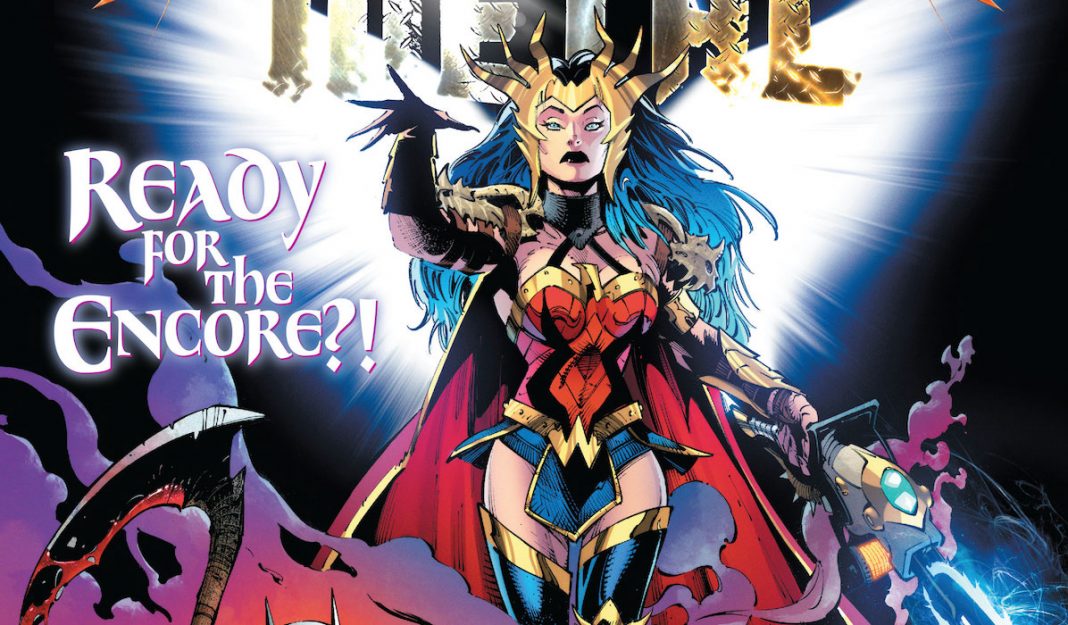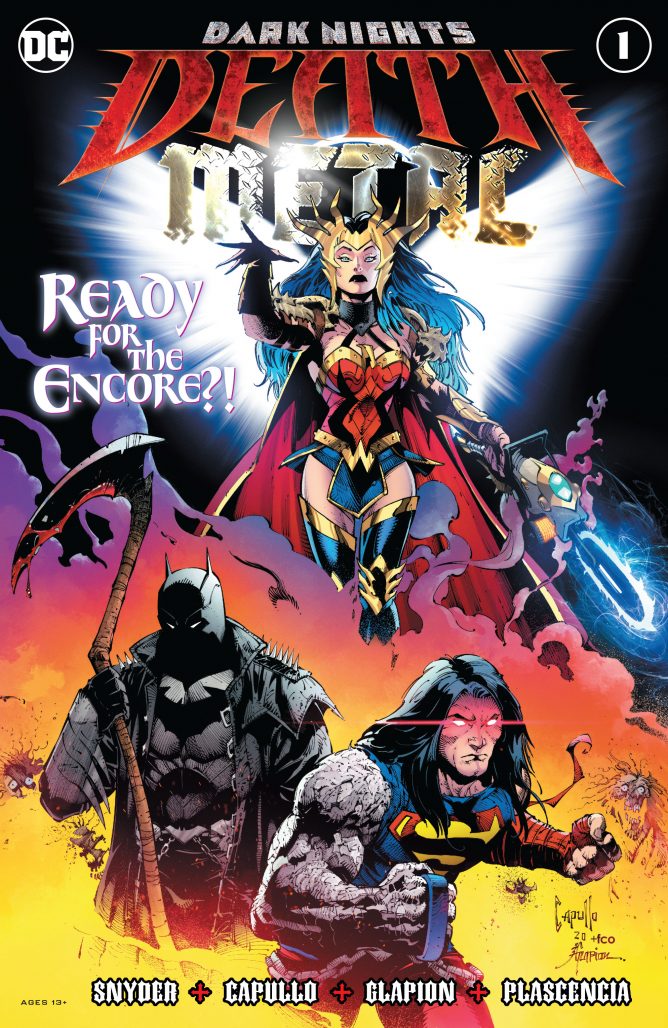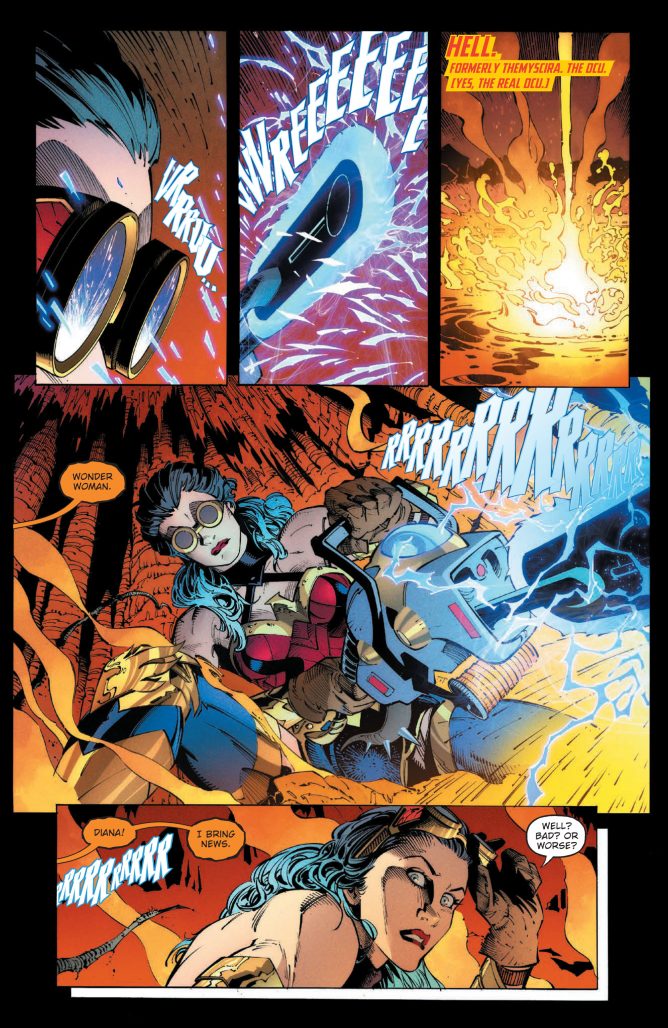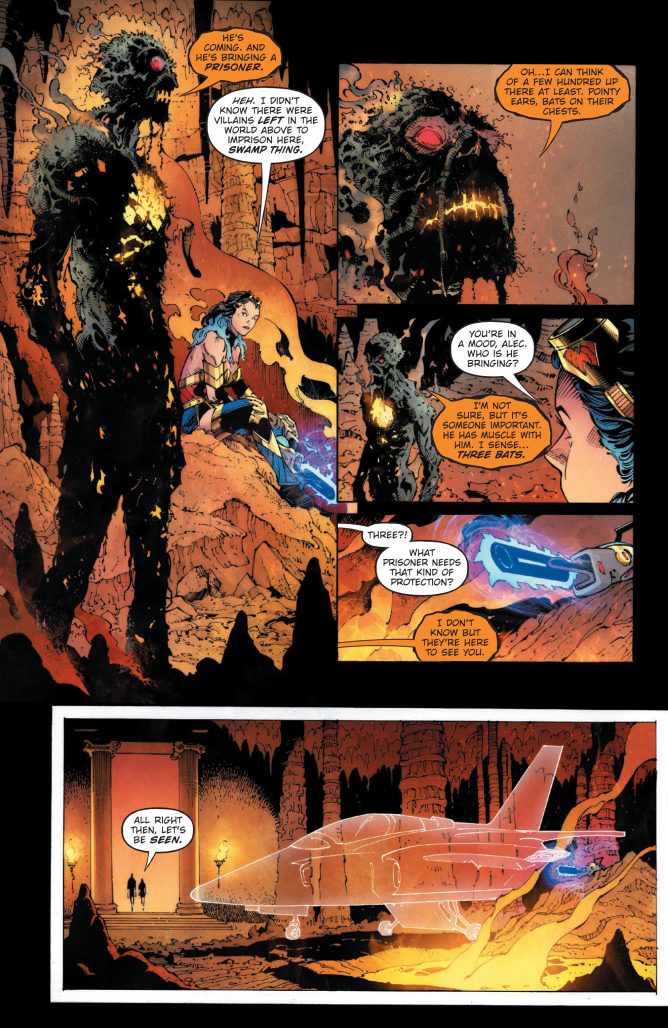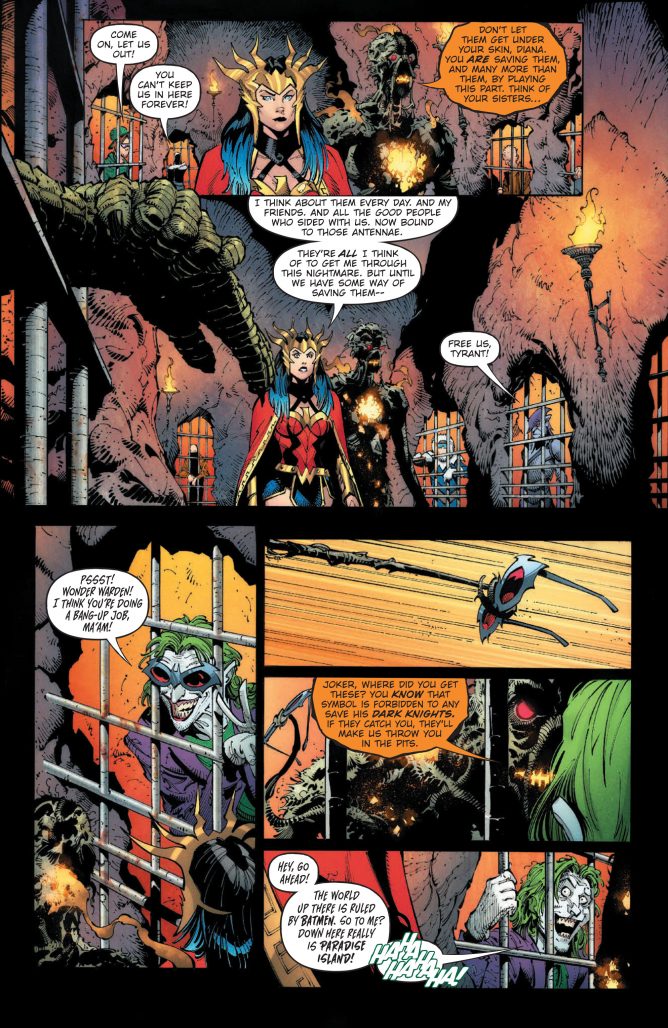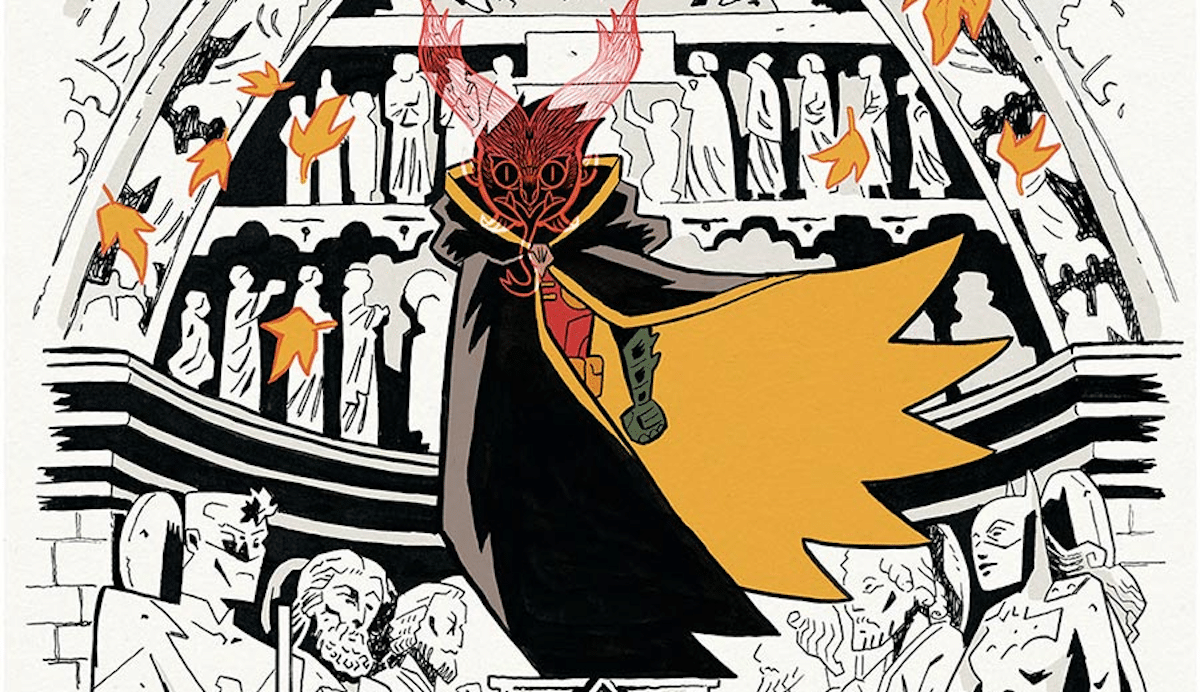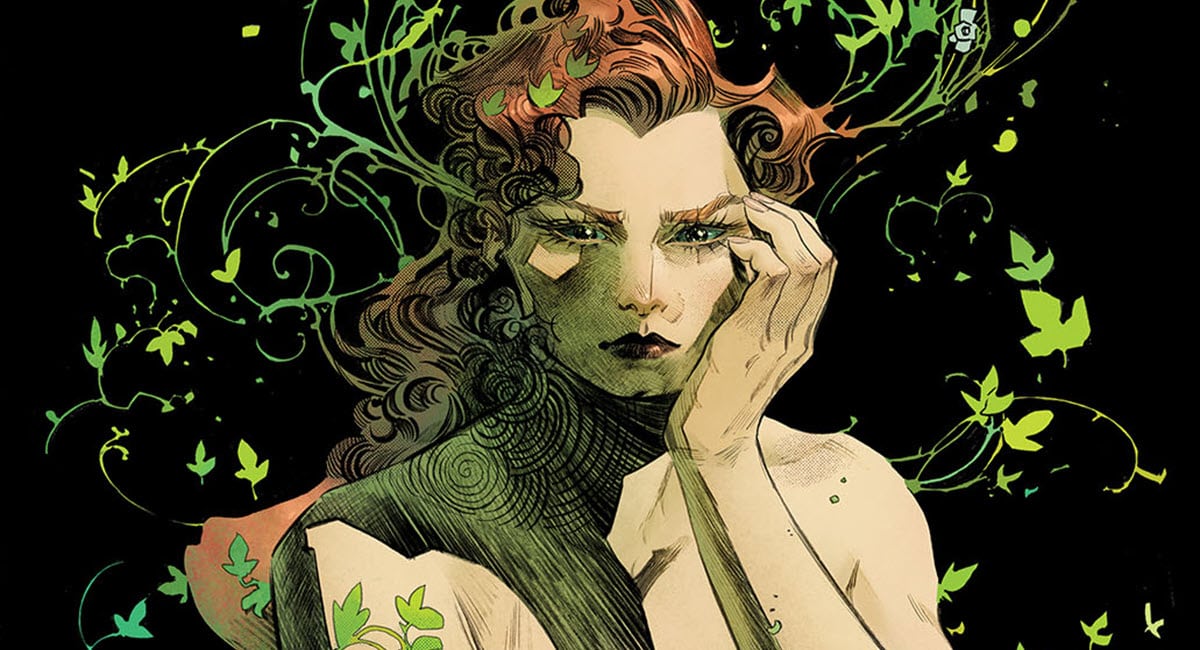Dark Nights: Death Metal #1 hits this week, and in advance of tomorrow’s new DC Comics release, we have the first lettered pages from the event, as well as a chat with writer Scott Snyder.
Dark Nights: Death Metal — for those who have somehow missed it — is a sequel to the first major DC Comics event of the Rebirth era, 2017’s Dark Nights: Metal. It’s also a culmination of some long-term and intricate storytelling that has been happening of late across DC’s mainstream superhero comics line, taking place in a wide range of titles, including Justice League, Tales From the Dark Multiverse, Batman/Superman, The Batman Who Laughs, and more.
The creative team is Snyder, artist Greg Capullo, inker Jonathan Glapion, colorist FCO Plascencia, and letterer Tom Napolitano. You can read the full solicit here, and you can hear what Snyder has to reveal about it below, along with the fully-lettered pages…enjoy!
ZACK QUAINTANCE: So, new comics are slowly coming back, and we’re about to get DARK NIGHTS: DEATH METAL. With the world having drastically changed since this book was announced. With that in mind, what do you broadly want to tell readers about DARK NIGHTS: DEATH METAL right now given everything that’s going on?
SCOTT SNYDER: One of the weirdest things is that the book was always about the world changing in a dark way so fast that the heroes almost don’t know how to process it, and it’s about the connectivity and connection between heroes and the good people in the world being the only way to get through. So, it wound up being way more resonant for the team as we’ve been working on it than it was initially. It was always a personal story.
It was about how comic books and superheroes bring us together at times we feel alienated from each other, alienated from any sense of community, and kind of alienated from stories, in terms of the stories themselves feeling disconnected from each other when things have gotten more siloed at times. About the need to make it one big epic generational story even if things are given respectful room to blossom on their own. For us, it was always about those things, and then this happened. It wound up being something that felt immediate and urgent, and the landscape at DC changed. We wound up having more room. We have seven issues instead of six, and more tie-ins and specials than we had before. It’s really become something that instead of being sort of detached from what was coming after it, now it’s setting stuff up after it. It become a much bigger and better and more important project to the line than it was before.
QUAINTANCE: Something I’m intrigued by is you mentioned online that there was almost a goal of it to sort through DC continuity. Without spoiling anything, can you tell us more about that?
SNYDER: The slogan for the event is a line Wonder Woman has in the first issue when she’s talking to the evil dinosaur robot Batman, and she says, ‘It all matters.’ That’s the post-it on the computer for all of us working on the book. More specifically it brings together the threads that Josh Williamson, James Tynion, and I, and Robert Venditti have been working on in multiple books since Metal. When we pitched Metal, we pitched this as a culmination of it if Metal worked. So, we’ve been building these parallel stories about The Batman Who Laughs through The Batman Who Laughs miniseries, through Batman Superman, through Year of the Villain: Hell Arisen, and we’ve been building a Lex Luthor storyline through Justice League and the Legion of Doom issues and again through Year of the Villain: Hell Arisen to sort of culminate through Death Metal.
But there are a lot of other stories that we wanted to bring in that we felt hadn’t had an impact in a while or maybe didn’t have the impact they were intended to have in different ways. This story is built on all of the former crises, from Crises on Infinite Earths all the way up through Final Crisis. It’s also built on Doomsday Clock. Without taking any of those stories and doing something that undoes them or changes the nature of them or anything like that — nothing that tramples them or does anything disrespectful — we wanted to build on the shoulders of those great stories and say, “This is how they’re all one really epic multi-faceted story that is the DC Universe now.”
The basic tenet of Death Metal is that the world has changed very suddenly. When the heroes fought Perpetua and lost, she gave control of the Earth to The Batman Who Laughs instead of Lux Luthor. She cast Luthor out of her Garden of Eden, sort of, and Batman Who Laughs — with this conduit to the Dark Multiverse — has armies of evil Batmen running the Earth. He’s shifted the balance of territories around so Wonder Woman rules over the prison for villains and she’s guarded by a sorcerer Batman and the prison is Themyscira. The prison for heroes is a new Apokolips and Mister Miracle is forced to watch it, and he’s guarded by a Darkseid Batman called Dark Father. There’s Aquaman who patrols the oceans looking for anyone who got away, and he’s ruled by Cthulhu Batman. Harley patrols the wastelands riding a mutant hyena, and she’s watched over by Dr. Arkham, a Bruce Wayne who ran Arkham and has evil man bats….that’s sort of how big and nutty we’re going bringing all these stories in that we feel are part of the great tapestry of DC lore, and how kind of out there we want to go with creating something that’s fun and different and our own.
QUAINTANCE: This is less of a question than it is a request for more info, but I saw you tease a dark Batman who is essentially a sentient Gotham City. Is there anything new you can tell us about that one?
SNYDER: He’s one of my favorites. He’s a Batman who when he was old had already handed the Batman mantle over to one of the family — I won’t give it away because the story is in one of the specials we’re going to do — and Gotham has just not held up correctly. The Bat-family member knows it, Batman knows it, so he finds an ancient rite deep in Gotham’s libraries that tells him how to infuse his soul through magic into the bricks of Gotham itself, and so he does.
He becomes a living version of the city, almost like Danny the Street. He sort of controls every fiber, every cell of Gotham. He’s an ever-morphing, living city. He forms Castle Bat, which is the headquarters of the Batman Who Laughs in Death Metal.
My other favorite is the B-Rex, which is a Batman who uploaded his consciousness to the robot dinosaur in the cave when the cave was collapsing on him in his world. Something went wrong and short circuited so he’s always really angry and Wonder Woman is always picking fights with him.
QUAINTANCE: I keep seeing that Wonder Woman will be central to this story. What drew you to her as one of the central characters for DARK NIGHTS: DEATH METAL?
SNYDER: We always wanted her to be the lead after we finished the last METAL and started planning this one. If METAL was about pushing past boundaries when you think you’re at your darkest point — trying to get together and get past what you thought was possible — this one is really about connection even beyond that. It’s about the truth in moments like these: you can’t really get anywhere without banding together and believing in things bigger than yourselves. So for us, it’s an expansion of the message in METAL. You live on through and you’re connected not only through the people around you at any one time, but through the actions and heroic deeds of everybody who fought for good before you and everyone who will fight for good after you.
What Wonder Woman realizes is that over the different generations at DC, Perpetua — through these crises and this energy the crises release or are powered by — has made contortions in the timeline. Certain stories are left out. Certain stories have become forgotten. Other stories are given precedence when they really only happened briefly. All of that stuff is the product in our mythology of the lie that is created by Perpetua’s knotting in different ways of the timeline. So we pitched this years ago, and this idea about the continuity itself needing to be one generation story.
That doesn’t mean the characters have to be 75 years old or anything like that, but it means understanding that the stories you loved happened in one way or another and are part of these characters’ collective memories and respecting that. Wonder Woman was always the right character because she’s the one who is looking for the truth about what it means to be part of this real legacy story that is the DCU. As a captain and kind of general as well of the whole army of heroes and villains in DEATH METAL — because everybody winds up teaming up in the end, spoiler — she’s the one who understands better than anybody that a warrior’s death — and that’s partly why it’s called DEATH METAL — is you live on through the things you do and the reverberations of your actions. That’s great than getting to be born young and new all over again.
QUAINTANCE: You’ve written so much in the DCU at this point, but were there any new characters you’d never written before that you got a chance to write in this story?
SNYDER: Right now I can tell you Jonah Hex and Sgt. Rock were crazy fun. I’m having a lot of fun with Superboy Prime as well. It really goes everywhere. They’re characters I’ve wanted to use in different ways for a long time, and I just haven’t had a chance.
QUAINTANCE: What’s next for you? This feels like it might be your DCU finale…is that your approach to it?
SNYDER: It’s my approach to it in terms of events and working with Greg together as a team. We’ve done a lot. This was initially going to be kind of an isolated thing, because we were doing it and we weren’t sure it was going to connect to the DCU on the other side or what its role was going to be, but it was a story we believed in from the beginning. Now, the landscape has changed a bit, and they want it to be more hooked in to what’s coming after it. There are places I’m excited to land and to write for DC in different ways. I definitely want to take a step back from the event level bombast, and Greg and I as a team, certainly want to try to do more of our own stuff and other things afterward. So, I see it definitely as the closure of an era and us doing kind of over-the-top DC stuff, at least for a while, to try other things possibly at DC but also our own stuff.
For me, it will signal a pivot toward other types of projects as well at DC and elsewhere. I’ll definitely still be around. I re-committed to the landscape at DC because it’s become so exciting to me what they’re building after METAL now, but I want to give other people a chance to do some of these giant things. I want to be able to work on the kinds of projects that will flex different muscles.
QUAINTANCE: Anything else you wanted to add about DEATH METAL?
SNYDER: Honestly, I’d love to add a thank you to everybody out there that keeps pumping life blood into the industry at this difficult time, especially retailers on the front lines and fans as well. DEATH METAL is definitely written as a thank you in that regard. You’ll see it on Page One with Sgt. Rock’s speech. He’s lost all his blood, so they think he’s crazy and hallucinating, but he’s kind of talking right at you, breaking the fourth wall. He says, “I see them out there! I knew they’d be there, they’d stick around after all this time, because they’re soldiers!”
He’s definitely partly out of his mind, but what he’s saying is what I want to say to retailers and fans and to everybody, everyone that’s keeping interest high and keeping blood pumping into comics because we’re all hoping it comes out of this stronger on the other side.
Dark Nights: Death Metal #1 is out in stores Tuesday, June 16.


